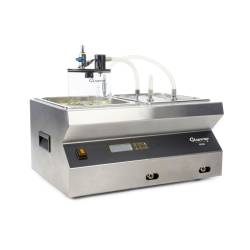The 100% Chef Girovap on RGmania.
The real innovation of this crazy 2020 is Girovap, Distiller Pro by 100% Chef. If you don't know what Girovap is, find out by reading the product sheet and related in-depth discussion.
If, on the other hand, you have already had a chance to read about its potential, you will be interested to know that RG has enlisted the support of Dario Comini, patron of the famous cocktail bar Nottingham Forest in Milan, and his colleague Tony Grimaldi, who have accumulated a long experience in the use of professional rotovapor, to introduce us to the technical details of Girovap. After this initial approach to mixing, we thought it appropriate to invite a qualified chef to help us get the machine up and running.
Chef Danilo Angè's creations
Discover the recipes we experimented with at RGmania headquarters with the invaluable help of our friend and chef Danilo Angè.
After publishing a book entirely dedicated to low-temperature cooking and one on siphons, we realized that Danilo was the right professional to help us better understand the potential of this innovative machinery.
Our tests went through 3 recipes with 3 different bases.
The first recipe
The first consisted of distilling hydrolates, or rather water flavored with hay, orange peel and spices, juniper berries and black peppercorns.
For a first experiment, we opted for the automatic function, set with the parameters suggested in the instruction manual and present already at the start-up, i.e. 55° as bath temperature (water in the left basin) and internal pot temperature of 35°C.
The time was one hour.
Critical to the success of the recipe is keeping the right tub coil and its container covered with ice at all times in order to keep the temperature very low. Ideally, it would be correct to obtain a temperature between 1 and 3°C. To be sure of succeeding, 100% Chef recommends using 3 kilograms of ice, 250 grams of salt and one liter of water . Thanks to the valve used to empty the gastronorms, you can gradually replace the melting ice with new ice.
Whatever the mixture you want to extract, distill, concentrate, reduce, the result you will always get will be a completely crystal clear liquid, which will then taste like the chosen ingredients. Therefore, the real advantage of processing the resulting mixture is to achieve a real WOW effect!
In Danilo's case, on the other hand, the idea was to obtain a hay water that could be siphoned with an injector inside a fillet to flavor it.
By inserting about 1.2 liters of water into the jar, we extracted about half a liter of product.
The second recipe
The second recipe was based on red wine, orange and lemon peel, sugar, honey, myrtle leaves, peppercorns, juniper berries and cloves.
Our primary goal was to be able to make a kind of cold mulled wine, instead imagine the surprise to discover that what we were doing was dealcoholizing our wine! In this case, the most interesting part of the job was not so much the result of the concentration, but the extraction of alcohol from the initial product.
By repeating the operation, the wine became lighter and lighter, infusing itself with aromas. This result may be of interest to those working with low-alcohol recipes, such as those under 21°.
To better understand the distillation process that takes place with Girovap, we remind you that every operation always takes place under vacuum-usually with a vacuum of -0.97 bar. Normally water reaches its boiling point at 100°C but under vacuum at 21.3°C - thus at an incredibly lower temperature. Why is this important? Because under vacuum and cold, ingredients retain their nutritional properties better and longer.
The last experiment of the day
As the last 'experiment' of the day, we tried reducing a drink made with alcohol, water, sugar, thyme, prickly pear and lemon peel.
As the manual suggests, for a better brew with solid ingredients it is always best to use, for every 500 grams of solid component, 100 grams of alcohol (excluding coffee).
For alcohol redistillation, it is recommended to always maintain a temperature that does not exceed 40°C. Our processing took a full 30 minutes.
Again, the most interesting processing for use was not that contained in the collection jar, but the waste processing of the initial product. Specifically, we filtered the solid product from the liquid one, thus obtaining a prickly pear-based alcohol and a compote of the fruit itself with thyme and lemon peel that could be easily gelatinized for various, uses in both sweet and savory.
Girovap 100% Chef: our impressions
From this first day of testing, our conclusions are simple but positive.
It is a machine that deserves to be used for different experiments, both in the kitchen and in the bar. The only suggestion we can make is that although it is easier to use than a classic rotovapor, it is necessary to have adequate knowledge of the ingredients and their processing to work in manual mode with the correct parameters, thus optimizing time and results.






